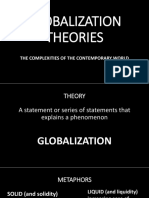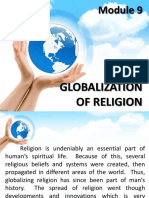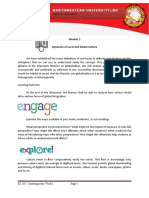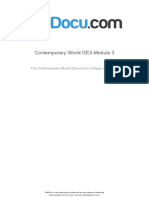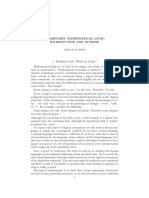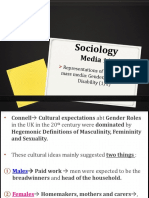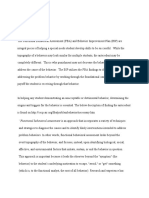0%(1)0% found this document useful (1 vote)
3K viewsDynamics of Local: and Global Culture
Dynamics of Local: and Global Culture
Uploaded by
Roland GramaticoThere are three perspectives on global cultural flows: differentialism, hybridization, and convergence. Differentialism emphasizes that cultures remain essentially different and interactions may lead to conflict. Hybridization focuses on the integration of local and global cultures resulting in unique blended outcomes. Convergence stresses homogeneity and dominance of one culture over others through globalization.
Copyright:
© All Rights Reserved
Available Formats
Download as PPTX, PDF, TXT or read online from Scribd
Dynamics of Local: and Global Culture
Dynamics of Local: and Global Culture
Uploaded by
Roland Gramatico0%(1)0% found this document useful (1 vote)
3K views9 pagesThere are three perspectives on global cultural flows: differentialism, hybridization, and convergence. Differentialism emphasizes that cultures remain essentially different and interactions may lead to conflict. Hybridization focuses on the integration of local and global cultures resulting in unique blended outcomes. Convergence stresses homogeneity and dominance of one culture over others through globalization.
Original Title
4-DYNAMICS-OF-LOCAL-AND-GLOBAL-CULTURE
Copyright
© © All Rights Reserved
Available Formats
PPTX, PDF, TXT or read online from Scribd
Share this document
Did you find this document useful?
Is this content inappropriate?
There are three perspectives on global cultural flows: differentialism, hybridization, and convergence. Differentialism emphasizes that cultures remain essentially different and interactions may lead to conflict. Hybridization focuses on the integration of local and global cultures resulting in unique blended outcomes. Convergence stresses homogeneity and dominance of one culture over others through globalization.
Copyright:
© All Rights Reserved
Available Formats
Download as PPTX, PDF, TXT or read online from Scribd
Download as pptx, pdf, or txt
0%(1)0% found this document useful (1 vote)
3K views9 pagesDynamics of Local: and Global Culture
Dynamics of Local: and Global Culture
Uploaded by
Roland GramaticoThere are three perspectives on global cultural flows: differentialism, hybridization, and convergence. Differentialism emphasizes that cultures remain essentially different and interactions may lead to conflict. Hybridization focuses on the integration of local and global cultures resulting in unique blended outcomes. Convergence stresses homogeneity and dominance of one culture over others through globalization.
Copyright:
© All Rights Reserved
Available Formats
Download as PPTX, PDF, TXT or read online from Scribd
Download as pptx, pdf, or txt
You are on page 1of 9
DYNAMICS OF LOCAL
AND GLOBAL CULTURE
Global flows of culture…
…tend to move more easily around the globe than ever
more, especially through non-material digital forms.
There are 3 perspectives or approaches of global
cultural flows:
1. Differentialism
2. Hybridization, and
3. Convergence
Cultural Differentialism
Emphasizes the fact that cultures are essentially
different and are only superficially affected by
global flows.
The interaction of cultures is deemed to contain
the potential for “catastrophic collision.”
Huntington’s theory on the clash of the civilization
proposed in 1996 best exemplifies this
(“catastrophic collision”) approach.
Cultural Differentialism
According to Huntington (2004), after the Cold War,
political-economic differences were overshadowed by
new fault lines, which were primarily cultural in
nature, increasing interactions among different
“civilizations” (such as the Sinic, Islamic, Orthodox,
and Western) would lead to intense clashes,
especially the economic conflict between the Western
and Sinic civilizations and bloody political conflict
between the Western and Islamic civilizations.
Cultural Differentialism
This theory has been critiqued
for a number of reasons,
especially on its portrayal of
Muslims as being “prone to
violence” (Huntington, 1996)
Cultural Hybridization
Emphasizes the integration of local and global cultures
(Cvetkovich and Kellner, 1997).
Globalization is considered to be a creative process
which gives rise to hybrid entities that are not
reducible to either the global or the local .
The key concept is “glocalization” or the
interpenetration of the global and local resulting in
unique outcomes in different geographic areas
(Giulianotti and Robertson, 2007, p.133)
Cultural Hybridization
Another key concept is Arjun
Appadurai’s “scapes” in 1996, where
global flows involve people, technology,
finance, political images, and media and
the disjunctures between them, which
lead to the creation of cultural hybrids.
Cultural Convergence
Stresses homogeneity introduced by
globalization.
Cultures are deemed to be radically
altered by strong flows, while cultural
imperialism happens when one culture
imposes itself on and tends to destroy at
least parts of another culture.
Cultural Convergence
One important critique of cultural
imperialism is John Tomlinson’s idea of
“deterritorialization” of culture.
Means that it is much more difficult to
tie culture to a specific geographic point
of origin.
You might also like
- 1 - Approaches To The Study of Globalization PDFDocument88 pages1 - Approaches To The Study of Globalization PDFpot pooot100% (2)
- Modelo Examen 1er Año Instituto CambridgeDocument3 pagesModelo Examen 1er Año Instituto CambridgeGuido Tamer33% (6)
- Lesson 3 Economic Globalization, Poverty, and InequalityDocument13 pagesLesson 3 Economic Globalization, Poverty, and InequalityCarlo Magcamit100% (2)
- Global Culture and Cultural FlowsDocument47 pagesGlobal Culture and Cultural FlowsElsha Damolo100% (2)
- Chapter 5 - Globalization of ReligionDocument35 pagesChapter 5 - Globalization of ReligionBLACK88% (8)
- Globalization TheoriesDocument29 pagesGlobalization Theoriesjames adam100% (2)
- The Globalization of Religion: Contemporary WorldDocument29 pagesThe Globalization of Religion: Contemporary WorldLorraine Velasco Abache100% (10)
- Chapter 4. World of IdeasDocument28 pagesChapter 4. World of IdeasJose Angelo Escupin100% (2)
- Steger - Approaches To The Study of GlobalizationDocument34 pagesSteger - Approaches To The Study of GlobalizationAubrey Jeenne Gullon89% (9)
- The Contemporary World Week 1Document25 pagesThe Contemporary World Week 1Julius MacaballugNo ratings yet
- Globalization of ReligionDocument51 pagesGlobalization of ReligionMoner Ramos-Datu100% (2)
- 2nd Globalization TheoriesDocument18 pages2nd Globalization TheoriesKimmy Quiambao100% (2)
- Contemporary WorldDocument22 pagesContemporary Worldkazumi yu100% (2)
- Chapter 4 A WORLD OF IDEAS CONTEMPODocument6 pagesChapter 4 A WORLD OF IDEAS CONTEMPOJackie Lou Romero100% (3)
- A World of RegionsDocument20 pagesA World of RegionsJyle Mareinette Maniago100% (4)
- Globalization of ReligionDocument11 pagesGlobalization of ReligionEloisa Amelyn DomingoNo ratings yet
- Lesson 2 - GEC 3 Contemporary WorldDocument8 pagesLesson 2 - GEC 3 Contemporary WorldCalacja 2 Hamtic Antique100% (1)
- Dynamics of Local and Global CultureDocument11 pagesDynamics of Local and Global CultureArlene Sumabong80% (5)
- Dynamic of Local and Global CultureDocument7 pagesDynamic of Local and Global CultureChristian Jim Polleros60% (5)
- 3 Dynamics of Local and Global Culture: Cultural Differential-IsmDocument2 pages3 Dynamics of Local and Global Culture: Cultural Differential-IsmFrancis Uriel Albiol ÜNo ratings yet
- Contemporary WorldDocument21 pagesContemporary WorldJerry Manatad100% (4)
- The Contemporary WorldDocument32 pagesThe Contemporary WorldAxel Ngan50% (2)
- Globalization TheoriesDocument38 pagesGlobalization TheoriesBernellie Mae Araneta50% (2)
- The Dynamic of Local and Global CultureDocument38 pagesThe Dynamic of Local and Global CultureAlondra L. FormenteraNo ratings yet
- 9 Globalization of ReligionDocument40 pages9 Globalization of ReligionTanja MercadejasNo ratings yet
- Globalization of ReligionDocument27 pagesGlobalization of ReligionJoana Roxas100% (4)
- Unit 2 - A World of Ideas: Cultures of Globalization: Sammy T. Perado, PH.D., MMT, REBDocument17 pagesUnit 2 - A World of Ideas: Cultures of Globalization: Sammy T. Perado, PH.D., MMT, REBjerald love patricia86% (7)
- Lesson 3 Origins and History of GlobalizationDocument12 pagesLesson 3 Origins and History of Globalizationave sambrana50% (6)
- Lesson 2 Economic Globalization and Sustainable DevelopmentDocument6 pagesLesson 2 Economic Globalization and Sustainable DevelopmentCarlo Magcamit100% (2)
- Module 4 - Lesson 1 - The Globalization of ReligionDocument4 pagesModule 4 - Lesson 1 - The Globalization of ReligionKai KimNo ratings yet
- Media and GlobalizationDocument45 pagesMedia and GlobalizationRegine Mae Garion50% (2)
- Module 4 - Market IntegrationDocument24 pagesModule 4 - Market IntegrationJeprox MartinezNo ratings yet
- Global DemographyDocument20 pagesGlobal DemographyLuna50% (2)
- Module 4: Globalization of Religion: Mr. Jovic B. Lim, LPT, Maed Mr. Arnold P. Santos, Lpt. Mr. Adrian D. Estudillo, LPTDocument28 pagesModule 4: Globalization of Religion: Mr. Jovic B. Lim, LPT, Maed Mr. Arnold P. Santos, Lpt. Mr. Adrian D. Estudillo, LPTLodicake0% (1)
- GlobalizationDocument18 pagesGlobalizationLouwell Abejo RiñoNo ratings yet
- Globalization of ReligionDocument16 pagesGlobalization of ReligionApril BuenoNo ratings yet
- Module CW 1 (Contemporary World)Document117 pagesModule CW 1 (Contemporary World)Doc M VillanuevaNo ratings yet
- Global Media CulturesDocument12 pagesGlobal Media CulturesReen Bughao100% (11)
- Chapter 1 - Introduction To The Study of GlobalizationDocument64 pagesChapter 1 - Introduction To The Study of Globalizationancaye1962No ratings yet
- Orca Share Media1558352210399Document12 pagesOrca Share Media1558352210399Niño Johnrick LaraNo ratings yet
- Lesson 10 Global DemographyDocument17 pagesLesson 10 Global DemographyChadAclanParas100% (1)
- Module 2 Dynamics of Local and Global CultureDocument5 pagesModule 2 Dynamics of Local and Global CulturekarlitaNo ratings yet
- Globalization and ReligionDocument16 pagesGlobalization and ReligionWayn Cahilig100% (1)
- Globalization and RegionalizationDocument28 pagesGlobalization and RegionalizationRoland Gramatico50% (4)
- 8 Global Media Culture Mass MediaDocument30 pages8 Global Media Culture Mass MediaJohn Icon Dela CruzNo ratings yet
- Lesson 6 The Globalization of ReligionDocument6 pagesLesson 6 The Globalization of ReligionEdielyn GonzalvoNo ratings yet
- Lesson#3 Theories of Global Stratification.Document11 pagesLesson#3 Theories of Global Stratification.Zeus P Diaz0% (1)
- The Globalization of ReligionDocument19 pagesThe Globalization of ReligionCadim'z Kyelloied100% (1)
- The Globalization of ReligionDocument26 pagesThe Globalization of ReligionRoland Gramatico100% (3)
- Globalization of ReligionDocument12 pagesGlobalization of ReligionRhowie Saylon0% (1)
- Gec103 - Week2 - Origins and History of GlobalizationDocument19 pagesGec103 - Week2 - Origins and History of GlobalizationAngel Joy Calisay67% (3)
- Globalization of ReligionDocument13 pagesGlobalization of ReligionRobert GarlandNo ratings yet
- Dynamics of Local and Global CultureDocument3 pagesDynamics of Local and Global Culturejeric mayugba43% (7)
- The Global Economy: Socsci 100 The Contemporary World 1Document52 pagesThe Global Economy: Socsci 100 The Contemporary World 1Camille Villena Valmadrid100% (2)
- Lesson 4 Theories of Global StratificationDocument14 pagesLesson 4 Theories of Global StratificationCarlo Magcamit0% (1)
- Lesson 4: Globalization Population and MobilityDocument56 pagesLesson 4: Globalization Population and MobilityAhrlynne Cuadrante Mendez RodaNo ratings yet
- Introduction To The Study of GlobalizationDocument23 pagesIntroduction To The Study of GlobalizationAntonio C. Cayetano100% (1)
- The Globalization ReligionDocument21 pagesThe Globalization ReligionShereen RodrigoNo ratings yet
- 7globalization and Media (30-40)Document11 pages7globalization and Media (30-40)Tam Gerald Calzado100% (1)
- Contemporary World GE3-Module 3 Contemporary World GE3-Module 3Document14 pagesContemporary World GE3-Module 3 Contemporary World GE3-Module 3Erica CanonNo ratings yet
- Dynamics of Local and Global Culture-1Document15 pagesDynamics of Local and Global Culture-1Anthony Robert RebaterNo ratings yet
- The Philippine Qualifications Framework (PQF) HARTDocument9 pagesThe Philippine Qualifications Framework (PQF) HARTRoland GramaticoNo ratings yet
- Central Philippines State University Central Philippines State UniversityDocument1 pageCentral Philippines State University Central Philippines State UniversityRoland GramaticoNo ratings yet
- Chapter 2 Lesson 1Document2 pagesChapter 2 Lesson 1Roland GramaticoNo ratings yet
- 2014-00-005 CGAF ApplicantsChildren PDFDocument1 page2014-00-005 CGAF ApplicantsChildren PDFRoland GramaticoNo ratings yet
- Final Output IN GEC.3 (Contemporary World) : Submitted By: Gramatico, Roland S. Bsed Filipino 1ADocument7 pagesFinal Output IN GEC.3 (Contemporary World) : Submitted By: Gramatico, Roland S. Bsed Filipino 1ARoland Gramatico100% (9)
- Chapter 2 Lesson 1Document2 pagesChapter 2 Lesson 1Roland GramaticoNo ratings yet
- Unit 5.1 BSED FIL 1ADocument2 pagesUnit 5.1 BSED FIL 1ARoland GramaticoNo ratings yet
- Prepared By: Ms. Rochelle S. Bobes, Instructor: Final Handouts in GEC 8 - EthicsDocument10 pagesPrepared By: Ms. Rochelle S. Bobes, Instructor: Final Handouts in GEC 8 - EthicsRoland GramaticoNo ratings yet
- Code of Ethics For Professional Teachers in The PHDocument5 pagesCode of Ethics For Professional Teachers in The PHRoland Gramatico100% (2)
- PPT. Unit 5.1 FIL 1ADocument9 pagesPPT. Unit 5.1 FIL 1ARoland GramaticoNo ratings yet
- UnderstandingtheselfDocument1 pageUnderstandingtheselfRoland GramaticoNo ratings yet
- 5.1 21. Gañgo, Liezel 22. Gramatico, Roland S. MMW Gec4 11/08/2019 10:30-12:00 NOON W-FDocument2 pages5.1 21. Gañgo, Liezel 22. Gramatico, Roland S. MMW Gec4 11/08/2019 10:30-12:00 NOON W-FRoland GramaticoNo ratings yet
- The Globalization of ReligionDocument26 pagesThe Globalization of ReligionRoland Gramatico100% (3)
- David W. KuekerDocument2 pagesDavid W. KuekerRoland GramaticoNo ratings yet
- The Philippine Qualifications Framework: Gango, Liezel Gramatico, Roland SDocument12 pagesThe Philippine Qualifications Framework: Gango, Liezel Gramatico, Roland SRoland GramaticoNo ratings yet
- Globalization and RegionalizationDocument28 pagesGlobalization and RegionalizationRoland Gramatico50% (4)
- Format Invoice NDPDocument7 pagesFormat Invoice NDPAiny AyNo ratings yet
- Упражнения по чтениюDocument7 pagesУпражнения по чтениюSanni KimNo ratings yet
- Unit 3Document13 pagesUnit 3Shadan Yaseen FarooquiNo ratings yet
- Heart of Darkness by Joseph Conrad: Themes, Characters, Symbols, StyleDocument16 pagesHeart of Darkness by Joseph Conrad: Themes, Characters, Symbols, StyleDaniela Matei Şora100% (1)
- The Assault On The Human Rights Act 1998Document21 pagesThe Assault On The Human Rights Act 1998Joshua RozenbergNo ratings yet
- ICICI Direct FAQ PDFDocument101 pagesICICI Direct FAQ PDFSanjeev KulkarniNo ratings yet
- Assignment 1Document4 pagesAssignment 1api-444846122No ratings yet
- Enga10 Speaking Test2Document2 pagesEnga10 Speaking Test2luana serraNo ratings yet
- Media 14Document26 pagesMedia 14Cheryl SJNo ratings yet
- 01 Bozalek Vivienne - 2014 Privileged Irresponsibility - in Moral Boundaries Redrawn The Significance of Joan Tronto's Argument - Part B 8-13Document6 pages01 Bozalek Vivienne - 2014 Privileged Irresponsibility - in Moral Boundaries Redrawn The Significance of Joan Tronto's Argument - Part B 8-13Miguel AgustínNo ratings yet
- Unit 3.4 CHP 1-4Document102 pagesUnit 3.4 CHP 1-4Thi Van Anh VUNo ratings yet
- Inspiring Minds Prashant Solanki: Prepared byDocument1 pageInspiring Minds Prashant Solanki: Prepared byPrashant SolankiNo ratings yet
- Cuspal Interlinks (Khullar System)Document2 pagesCuspal Interlinks (Khullar System)Richardson DashNo ratings yet
- b1 Lines Written in Early SpringDocument8 pagesb1 Lines Written in Early Springsahej48007No ratings yet
- (DLP) RPT MODULAR MT KSSR SEMAKAN Year 3Document14 pages(DLP) RPT MODULAR MT KSSR SEMAKAN Year 3Tamilarrasi RajamoneyNo ratings yet
- Progress Test 10Document6 pagesProgress Test 10Yến NhiNo ratings yet
- Letter To My TeacherDocument2 pagesLetter To My TeacherashanigeraldNo ratings yet
- Basic English Teacher: Juan AcostaDocument3 pagesBasic English Teacher: Juan AcostaJuanARNo ratings yet
- Answer:: Give One Example of Industry That Applies Any of The Principles of Weber's Bureaucracy / Taylor or Fayol TheoryDocument2 pagesAnswer:: Give One Example of Industry That Applies Any of The Principles of Weber's Bureaucracy / Taylor or Fayol TheoryJema TanNo ratings yet
- Buseco Cover LetterDocument2 pagesBuseco Cover LetterAAA820No ratings yet
- INFOSYS GRAND TEST-1.protectedDocument9 pagesINFOSYS GRAND TEST-1.protectedsaieswar4uNo ratings yet
- Models of CommunicationDocument45 pagesModels of CommunicationShassi KumaranNo ratings yet
- We Use Cookies To Ensure You Get The Best by Continuing To Browse Our Site, You Are Agreeing To Our Use of Cookies. Find Out MoreDocument8 pagesWe Use Cookies To Ensure You Get The Best by Continuing To Browse Our Site, You Are Agreeing To Our Use of Cookies. Find Out More07BUGAYONG, GERALDINE D.No ratings yet
- 6105 FB and BIP ProcessDocument4 pages6105 FB and BIP ProcessTammie ZentgrafNo ratings yet
- Artificial Intelligence B2 TVDocument6 pagesArtificial Intelligence B2 TVCarolineNo ratings yet
- Lex Libris SearchesDocument12 pagesLex Libris SearchesDean Ben100% (1)
- Aaj Sawal Hai ArticlesDocument67 pagesAaj Sawal Hai ArticlessonkNo ratings yet
- AcidDocument14 pagesAcidTochits MatiasNo ratings yet
- Individual Drug ResponseDocument18 pagesIndividual Drug ResponseIlham rianda100% (1)





